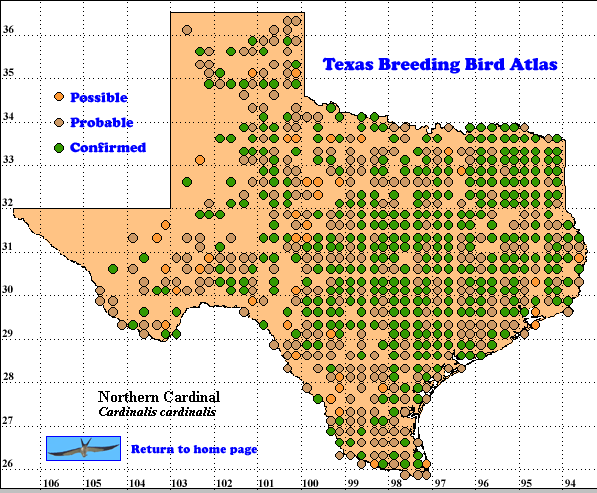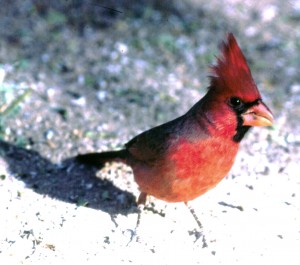Cardinalis cardinalis
Northern Cardinal, the state bird of 7 states, is a familiar sight at bird feeders throughout the eastern United States. The activities of humans, from forest clearing to bird-feeding, have enabled this adaptable bird to expand its range northward from the mid-Atlantic states to New York, New England and southern Canada. Similar northward expansions have occurred in other parts of the United States (Harkin and Linville 1999).
Where their ranges overlap, male cardinals and Pyrrhuloxias (C. sinuatus) are easily distinguished by plumage differences, but the plumages of females and immatures are more similar. Bill shape and color are the best clues.Vocalizations of these two species are very similar (Oberholser 1974, Pyle 1997).
DISTRIBUTION. During the 1987-1992 field work of the TBBA project, volunteers found Northern Cardinals breeding widely throughout the eastern half of the state to the western edges of the Rolling Plains and Edwards Plateau. Breeding is more scattered at the western edge, on the High Plains and in the eastern Trans-Pecos regions (see the map of regions in Lockwood and Freeman [2004]).
Cardinals were detected in Texas at relative abundances as high as 138, 131 and 119 individuals on three Breeding Bird Survey (BBS) routes in the Coastal Sand Plain and Pineywoods regions. These three averages were the highest for any routes in the United States. Elsewhwere in the eastern two-thirds of the state route averages were in the range of 10-100 cardinals per route (Price et al 1995, Sauer et al. 2005)..
Cardinals also reside from southern Minnesota, central Wisconsin, south Michigan, south Ontario, New York and south New England south to the Gulf Coast (Sauer et al. 2005).
From Texas the year-round range extends south on the central plateau of Mexico to the volcanic belt and on the coastal plain south through the Yucatan Peninsula. Other populations of cardinals are resident in the Sonoran Desert of Arizona and northwest Mexico, Baja California Sur and the southwest coast of mainland Mexico (Howell and Webb 1995, Pyle 1997, Harkin and Linville 1999).
SEASONAL OCCURRENCE. The Northern Cardinal is a permanent resident in Texas with a breeding season extending from as early as January to late August, based on egg dates from March 3 to July 31 (Oberholser 1974) and TBBA confirmed breeding records. Atlasers found an adult on a nest on January 16, and recently fledged young from February 23 to August 1. May with 32 confirmed records was the peak month for breeding, followed by June (22), April (19), March (13), July (8) and January, February and August with one each.
BREEDING HABITAT. The cardinal breeds from near sea level to 1500 m (5000 ft) in Texas. In the more humid eastern half of the state this species breeds in a variety of habitats in towns and in the country wherever trees and bushes are present, but not in deep forests. It adapts well to humans and their surroundings and is a common visitor to bird feeders Cardinals are less common in the more arid west, usually found in riparian areas and around human habitations. Cardinals commonly nest in more humid and more heavily vegetated areas than do Pyrrhuloxias (Lemon and Herzog 1969, Oberholser 1974, Lockwood and Freeman 2004).
The cardinal nest is placed in a small tree, shrub, vine or brier tangle 1-6 m (3-20 ft) above ground. The female builds the bowl-shaped structure, wedged into position among twigs and branches, from twigs, leaves, grasss, forb stalks, vines and bark strips. The structure is lined with fine grass and bark (Harrison 1979, Harkin and Linville 1979). No study has documented inter-nest distances, but a pair of “adjoining” nests has been found in Texas (Telfair 2007).
The usual clutch is 2-3 (range 1-5) smooth, grayish to greenish-white eggs (see Harrison [1979] for a photo of markings). The eggs are indistinguishable from those of the Pyrrhuloxia. The female incubates the eggs for 11-13 days and the young leave the nest about 7-13 days after hatching and continue to be fed by their parents, at least occasionally for another 3.5-8 weeks. Cardinal pairs have raised as many as 4 broods per season. Although parasitism by Brown-headed Cowbirds (Molothrus ater) is as high as 100% of cardinal nests in some areas, effect on cardinal reproductive success is not statistically significant and cowbird reproductive success is very low. Parasitism by Bronzed Cowbirds (M. aeneus) has also been reported (Harrison 1979, Harkin and Linville 1999).
STATUS. Northern Cardinal is common to abundant throughout most of Texas (Lockwood and Freeman 2004). At 2 sites at Welder Wildlife Refuge in southern Texas, densities ranged from 30 to 87 breeding pairs per 40 ha (100 acres; Lemon and Herzog 1969).
BBS data from 171 routes in Texas show a statistically significant +0.6% yearly population change for the period 1966-2005 and a +0.9% trend for 1980-2005, very similar to continent-wide trends (Sauer et al. 2005). Text by Robert C. Tweit (2007)
 Literature cited.
Literature cited.
Harkin, S. L. and S. U. Linville. 1999. Northern Cardinal (Cardinalis cardinalis). InThe Birds of North America, No. 440 (A. Poole and F. Gill, eds.). The Birds of North America, Inc., Philadelphia, PA.
Lockwood, M. W. and B. Freeman. 2004. The TOS handbook of Texas birds. Texas A&M University Press, College Station.
Telfair II, R. C. 2007. Adjoining nests of Northern Cardinal. Bull. Texas Ornith. Soc. 40: 36-37.
